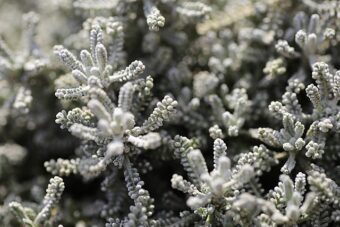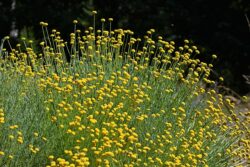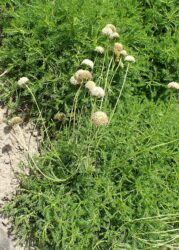In this article, we will discuss how to grow the beautiful dwarf shrub of Santolina in containers. Santolina is often given the common name of cotton lavender, because of its vague resemblance to Lavender. Santolina is a relatively small genus of 19 species belonging to the Asteraceae (Aster) family and to the tribe Anthemidae (the Chamomile tribe).

They tend to be found all over the Western Mediterranean region. What is common with all Santolinas is that they are small, low-growing, mound-forming, evergreen bushes that look great in containers.
It is grown for both its flowers and foliage, although some are simply grown for their leaves and the flowers are removed. The leaves tend to be simple and minute in some species whilst in others, the leaves are long and finely divided giving a ferny-like appearance. The leaves often have a silvery sheen and are hairy or they can be green. No matter what the colours are the leaves are very aromatic.
On top of the leaves in summer, small button-like flowers appear on thin stalks. The flowers can be either pale yellow to bright yellow. Many species that once belong to the Santolina species have been moved to other genera, so it has been slimmed down.
They are easy to grow as will be demonstrated in this article, where you will find out how to grow them in containers.
GROWING SANTOLINA IN CONTAINERS
As they are small shrubs, you will not need a large container, but a 15cm in diameter should be sufficient. First, choose a container that has sufficient holes at the bottom to allow the excess water to drain away. On top of the bottom of the container add a 2cm layer of gravel to aid drainage even further, they are not fussy as to what compost is used, so use what multipurpose you have on hand. Fill the container to within 5cm below the upper rim with this compost.

Dig a hole at the centre of the container slightly bigger than the root ball it came in the original pot you bought it in. Place the plant in so that the top of the root ball is at the same level as the top surface of the compost in the container. Backfill with the growing media so that no vacant areas remain, using more compost if you find it necessary. Firm the plant in well and water at the same time to allow the compost to settle around the roots.
THE BEST GROWING CONDITIONS
This is one sun-loving plant and must be grown in a sunny spot. In the shade, it will hate it.
This is one plant that hates being waterlogged. It needs to be watered regularly until it is well-established, which means watering once the surface of the compost feels dry to the touch. Otherwise, water when 5cm below the top surface of the compost feels dry to the touch. Only water until it emerges from the drainage holes at the bottom. If it is not watered right it can be a short-lived bush.
Feeding is not totally necessary but you can give an initial boost by feeding in spring with a general-purpose, slow-release fertilizer at half its recommended strength. This should give enough nutrients to last through the growing season.
Pruning is very simple, after it has flowered all you need to do is give a light trim. This will not only make it neat but will keep it as a dense, compact shrub. Every 2 to 3 years, you can cut back hard on April as this will keep it looking its best.
PESTS AND DISEASES
The good news is that if you are looking for a plant that does not suffer from pests and diseases that this is the shrub for you.
VARIETIES TO GROW
The three species you are likely to find in the UK include:

Santolina chamaecyparissus which grows up to 60cm tall. It has the familiar display of silvery leaves but tends to have a poor show of lemon-coloured flowers. ‘Nana’ is a 30cm miniature for containers. A noted variety is ‘Lemon Fizz’.
A taller species is Santolina pinnata which grows up to 75cm tall. It has creamy white flowers and the familiar fern-like foliage. ‘Neopolitana’ has bright yellow flowers and ‘Edward Bowles’ has creamy ones.
For a better floral display can be found if you grow Santolina rosmarinifolia which has thread-like, bright green leaves. On top of these on thin stems, masses of lemon-yellow flowers appear.
CONCLUSIONS
In this article, we have discussed how to grow the beautiful flowering and foliage plant of Santolina in a container. You have plenty of choices as to what variety to grow and all of them are easy to grow and care for.
They tend to be pests and diseases free so are easy for those who have difficulty growing plants.
If you have any questions or comments that you wish to make on growing Santolina in containers, please do so in the comment box below.
Happy Santolina growing.
